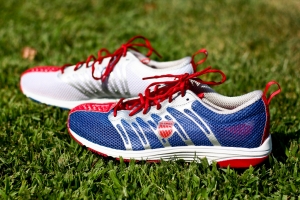I’ve been training for my first marathon, which is now three weeks away. That means I have been running—a lot. And thinking about running—a lot.
 Running or Buying Marathon?
Running or Buying Marathon?
I have always thought of running as simple, and for the most part, it is. But my romantic notion that all I need is a pair of running shoes and some open road is a bit naive. As it turns out, there is a lot more planning and gear that goes into training and running 26.2 miles. According to the experts, there are dozens of things that can make or break an endurance run: sneakers (multiple pairs —“barefoot,” stability control, minimalist, neutral, etc.), thin, antimicrobial socks, sweat-wicking clothing (endless permutations of shirts and tanks, coats and vests, tights and shorts), compression socks, hats and visors, sun-shielding sleeves, Map My Run iPhone apps, anti-chafing cream, “fuel” belts…it’s dizzying. Then comes the nutrition and hydration: energy drinks, protein and carb-filled foods, gels, “gu’s” and “shot blocks…” Of course, there is a market out there for all this running stuff and manufacturers lined up to sell it—even if we don’t need it.
FUD Marketing
I’ll go ahead and state the obvious: running is big business. And it is easy to feel preyed upon by marketers, especially given the fears we have related to injury. So-called fear, uncertainty and doubt (FUD) marketing is a classic emotional appeal. You’d think that the right shoes, sports-bra and UV-protective shirt were going to save your life. Last week, my sister (who is running her first marathon with me) went into an athletic store to stock up on power bars and got to talking with a sales person. After sharing some of her nagging aches and pains, she ended up getting talked into a new pair of running shoes – three weeks before the marathon! Everything I’ve ever read says you don’t want to make any changes to your gear that close to the event, especially something as core as your shoes. My sister had mentioned to the sales person that her feet hurt on her 18-mile run. His solution was that she needed new sneakers—and she bought them. Well, duh! Of course your feet will hurt if you run for 3 hours. There’s not a shoe in the world that will fix that (though some may claim otherwise). I spoke with my sister shortly afterward and told her to go back. She didn’t need new shoes and the salesperson should be ashamed for selling her a pair of sneakers when what she really needed was some reassurance. A few days later after chatting with a different salesperson, she was told her old shoes were just fine and she shouldn’t make a change in her sneakers so close to the race. But level heads did not prevail. To add insult to the original injury, the store wouldn’t take back the sneakers she just bought!
Serving Customers is Like a Marathon
The moral of this story: sometimes, it’s better to not sell something in the short term in order to do the best thing for your customer. My sister and I, and many others in our extended circle of friends and families, will continue to shop for athletic gear for years. With this one “sprint for a single sale,” the offending store has lost what could have been a marathon of multiple purchases over many years.
Eye on the Prize
I, too, am caught up in the frenzy of acquiring gear and getting everything dialed just right. I was video-taped by a local shoe store, purchased more than a few different pairs of sneakers, multiple types of socks and gobs of pre/during/post-race food. I’ve experimented with clothing and obsessed over routes and pre-run meals. After hearing my sister’s shoe story, I feel like I need to take a step back from the noise, think long term and remember why I’m doing this. I want to test myself and accomplish my goal. And ideally, it will be fun.



Running a Good Customer Marathon | Change Conversations http://t.co/HFhnHiVbmD
Running a Good Customer Marathon | Change Conversations http://t.co/bxGCBUUVdr #MondayBlogs